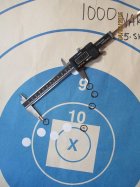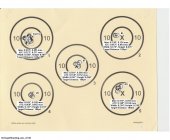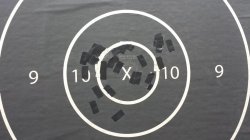Quick and easily understood responses are what got you to over 100 page's. Thanks for helping. Wish I could find people as knowledgeable and willing to help nearby to me as the members of this forum.Erik Cortina said:Hollywood said:How much does the chrony data play into the choice of load to take to the next step. I know it is another piece of useful info but how does it fit in the equation and is it necessary for optimal results?Erik Cortina said:fspitzdorf, do you have any chronograph numbers for this test?
If there are more than one node that look good, the one with the lowest ES will be the one that will shoot best at long range. Chronograph data is one of the most important things in this step since it will tell us which load is the most consistent and will shoot best at LR.
You are using an out of date browser. It may not display this or other websites correctly.
You should upgrade or use an alternative browser.
You should upgrade or use an alternative browser.
Long range load development at 100 yards.
- Thread starter Erik Cortina
- Start date
Erik Cortina
Team Lapua Brux Borden Captain
P3S said:This is the results from the load I developed with the guidance from Mr Cortina// page 99 has the data// 5-shot group under 5" at 1000 yards
Nice group!
I dropped 23.3 from the RCBS uniflow and shot 66 of them last Saturday. 193-7X, 192-5X, 197-6X. Killed the spotter on my second shot for record into the third string. All shot with aperture sights, slung.
I think I may load the two noticeable nodes again and run them over a chronograph. Obviously any of these loads are adequate for mid-range (300, 500, 600) with aperture and slung on the applicable NRA targets. But I also want to use this rifle with an optic for some long range prone (2,3,4,5 and 600) on super tough targets or local egg shoots and whatever else.. Not sure where to go with the Bergers. Closer to the rifling or further out. I don't want to jam them since I obviously may be required to make safe at some point during a string.


I think I may load the two noticeable nodes again and run them over a chronograph. Obviously any of these loads are adequate for mid-range (300, 500, 600) with aperture and slung on the applicable NRA targets. But I also want to use this rifle with an optic for some long range prone (2,3,4,5 and 600) on super tough targets or local egg shoots and whatever else.. Not sure where to go with the Bergers. Closer to the rifling or further out. I don't want to jam them since I obviously may be required to make safe at some point during a string.
Erik, what would be your comment to this ? (from another forum) I've focused mainly on ES and keeping it low.
Thanks
__________________________________________________________________________
You may want to run them both over the chronograph and see which one has the lowest SD. SD is a good indicator of vertical dispersion and we feel it is the more important of the two measurements between ES & SD.
---
Pay more attention to the SD and the velocity than the ES. You may want to add a target in the mix so you can see whats happening on paper. The target is always the final judge. The chrony and everything else is just a "suggestion" of what may work. IMHO.
__________________
Take care!
Phil Hoham
Berger Bullets Tech
Thanks
__________________________________________________________________________
You may want to run them both over the chronograph and see which one has the lowest SD. SD is a good indicator of vertical dispersion and we feel it is the more important of the two measurements between ES & SD.
---
Pay more attention to the SD and the velocity than the ES. You may want to add a target in the mix so you can see whats happening on paper. The target is always the final judge. The chrony and everything else is just a "suggestion" of what may work. IMHO.
__________________
Take care!
Phil Hoham
Berger Bullets Tech
Erik Cortina
Team Lapua Brux Borden Captain
wedgy said:Erik, what would be your comment to this ? (from another forum) I've focused mainly on ES and keeping it low.
Thanks
__________________________________________________________________________
You may want to run them both over the chronograph and see which one has the lowest SD. SD is a good indicator of vertical dispersion and we feel it is the more important of the two measurements between ES & SD.
---
Pay more attention to the SD and the velocity than the ES. You may want to add a target in the mix so you can see whats happening on paper. The target is always the final judge. The chrony and everything else is just a "suggestion" of what may work. IMHO.
__________________
Take care!
Phil Hoham
Berger Bullets Tech
ES is more important because in the game we play, I don't care if 19 shots have a very low SD, but if the 20th shot has a huge speed difference, that shot will cost you a point even though the SD is still low.
Erik Cortina
Team Lapua Brux Borden Captain
Hollywood said:Erik,
In regards to your sample target from the first page of this thread. After finishing the fine tuning of the 40gr load. How much smaller did the group size shrink down? Is the consistency of the load considered better even if the grouping may not be the smallest?
I don't remember what it did at 100 yards but I found some data that said that it shot .52" groups at 300 yards.
Also found this written on my notes:
" Update 3/11/2011: Won the March 2011 1000 YD. match, 0.7 MOA vertical at 1000 yards shooting in very heavy mirage, LOAD IS A KEEPER! "
[br]Hollywood said:Definatly a keeper!
Interested to see if what any of the other people's groups ended up like at 100 after final choice and tuning.
Here's a 100 yard tuner target and a subsequent 1000 yard match target. I used tuner setting #5 and the match target is 22 shots in 7.65". Tuner setting was after charge and primer selection and seating depth testing.
Attachments
How much did the groups shrink from the first step of charge testing to before you put the barrel tuner on. That barrel tuner did do a heck of a job.Steve Blair said:[br]Hollywood said:Definatly a keeper!
Interested to see if what any of the other people's groups ended up like at 100 after final choice and tuning.
Here's a 100 yard tuner target and a subsequent 1000 yard match target. I used tuner setting #5 and the match target is 22 shots in 7.65". Tuner setting was after charge and primer selection and seating depth testing.
I didn't have the components or money to keep going, but my last load showed no difference in tuner testing vs initial group size from seating depth. I went as far as 30 clicks out on tuner. Groups did not decrease in size, at end they actually got larger.
Just my experience. Maybe my load just was tuned from get go
Just my experience. Maybe my load just was tuned from get go
[br]Hollywood said:How much did the groups shrink from the first step of charge testing to before you put the barrel tuner on. That barrel tuner did do a heck of a job.
The barrel tuner was on during all prior testing, tightened against the shoulder. Groups during seating depth testing ran around .25-.50". During charge testing, around .35-.60".
Erik Cortina
Team Lapua Brux Borden Captain
savageshooter86 said:I didn't have the components or money to keep going, but my last load showed no difference in tuner testing vs initial group size from seating depth. I went as far as 30 clicks out on tuner. Groups did not decrease in size, at end they actually got larger.
Just my experience. Maybe my load just was tuned from get go
Contradicting sentences. If it showed no change, then how did the groups get bigger?
If groups changed at all, either got bigger or got smaller, then the tuner was working.
Sorry. Meant didn't change for the better. Not saying they don't work. Just couldn't get it to show improvement for my rifle/load. Didn't want to keep going. Used 60+ rounds trying to tune load with tuner
I'm going to try tuner testing at 1000 yards to see if it shows
I'm going to try tuner testing at 1000 yards to see if it shows
Brians356
Silver $$ Contributor
savageshooter86 said:Sorry. Meant didn't change for the better. Not saying they don't work. Just couldn't get it to show improvement for my rifle/load. Didn't want to keep going. Used 60+ rounds trying to tune load with tuner
Might be better to so the tuner setting first, then do the load / jump testing around that tuner setting. The tuner seems like a higher-amplitude variable, if that makes sense.
I load 4 of each powder charge in 0.5 gr. increments and seat bullets at jam - .020". I use one shot of each to get barrel fouled up and also keep an eye for max pressure at the same time. You can also use these rounds to break in a barrel if you are inclined to. If I encounter pressure on the hotter rounds, I will not shoot groups with the other loaded rounds and will pull bullets when I get back home.
Eric,
Are you cleaning the barrel between each groups?
Thanks
Eric,
Are you cleaning the barrel between each groups?
Thanks
Erik Cortina
Team Lapua Brux Borden Captain
warbird2006 said:I load 4 of each powder charge in 0.5 gr. increments and seat bullets at jam - .020". I use one shot of each to get barrel fouled up and also keep an eye for max pressure at the same time. You can also use these rounds to break in a barrel if you are inclined to. If I encounter pressure on the hotter rounds, I will not shoot groups with the other loaded rounds and will pull bullets when I get back home.
Eric,
Are you cleaning the barrel between each groups?
Thanks
No.
Similar threads
- Replies
- 61
- Views
- 14,527
Upgrades & Donations
This Forum's expenses are primarily paid by member contributions. You can upgrade your Forum membership in seconds. Gold and Silver members get unlimited FREE classifieds for one year. Gold members can upload custom avatars.

Click Upgrade Membership Button ABOVE to get Gold or Silver Status.
You can also donate any amount, large or small, with the button below. Include your Forum Name in the PayPal Notes field.
To DONATE by CHECK, or make a recurring donation, CLICK HERE to learn how.

Click Upgrade Membership Button ABOVE to get Gold or Silver Status.
You can also donate any amount, large or small, with the button below. Include your Forum Name in the PayPal Notes field.
To DONATE by CHECK, or make a recurring donation, CLICK HERE to learn how.












